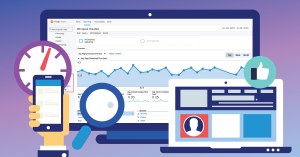To improve your content marketing, you need to study your existing content, then combine that information with what you know about your competitors’ content. With thorough, qualitative analysis, you’ll get valuable data, including visitors’ preferences, interests, and when they are likely ready to convert.
First, find out if your existing content is optimized. Nearly half of consumers expect a site to load in less than two seconds, so you may lose conversions just because of slow site speed. Once your site runs quickly, make sure it guides visitors through the funnel. Find information in Google Analytics about your visitors’ behavior and where they spend time on your site. Once you have your data, create new content based on these findings to make the funnel more efficient.
Google Analytics offers a wealth of information for content marketers: pageviews, pages/visit, average dwell time, and more. Review your data and you’ll find that visitors, through their actions on your site, are telling you what content they enjoy most. Learn more in the infographic below.
Why Analyzing Visitor Behaviour is the Perfect Content Hack
- Of B2C marketers who use content marketing
- 10% think it’s very effective
- 28% think their efforts are effective
- 40% are neutral
- 19% say it’s not very effective
- 4% think it’s not at all effective
- B2B marketers report similar findings
- 6% think it’s very effective
- 24% think their efforts are effective
- 44% are neutral
- 22% say it’s not very effective
- 4% think it’s not at all effective
Improve Your Content and Its Effectiveness with Data
- Check the popularity of your website’s content
- Google Analytics
- Engagement
- Social shares
- Research your competitors’ website content
- Check the performance of your guest posts and external media
- Analyze your social media posts
- Facebook Insights
- Twitter Analytics
- Social media management software
-
What will this data tell you?
- Visitors’ preferences and current product or content interests
- Where individuals are within the buying or customer life cycle
- When they are likely ready to be persuaded, converted, or up-sold
- When timely action must be taken to retain them
- Which offers will be most relevant and persuasive
- How much each individual may be willing to spend
Learn if Your Current Content Needs to be Optimized
· 47% of consumers expect a web page to load in 2 seconds or less
· 40% of people abandon a website that takes more than 3 seconds to load
· A 1 second delay in page response can result in a 7% reduction in conversions
- Go to Google Analytics > Behavior > Site Speed
- Is content slowing your pages down?
- Learn where you need to optimize
- Your images may slow down your pages
- Size images appropriately
- Reduce color depth to the lowest acceptable level
- Remove image comments
- Use JPEG or, when necessary, PNG
- If you have GIFs, use them sparingly
- Do not use BMPs or TIFFs
- Make sure your HTML code is correct—avoid empty image src codes
- In HTML, the code for an image includes <img src=””>
- When the quotation marks are empty, the browser makes a request to the directory of the page or to the actual page itself
Make Sure Your Website Content Guides Visitors Through the Funnel
- Visit the Behavior section in Google Analytics
- Reveals what your visitors do on your website
- hich pages people visit
- What actions do they take while on your site?
- Look at your Behavior Flow report
- See the path visitors commonly take on your website
- What was the first page they viewed?
- What was the last page they visited before leaving your site?
- If returning visitors are more likely to convert
- Push to get first-time visitors back onto your website
- Ask them to subscribe to your blog or email list
- If new visitors are more likely to convert
- Use conversion optimization strategies that grab people on their first visit, such as exit intent pop-ups
- Ask for their email address
- Offer a discount code as they leave your site
- Analyze every landing page on your site
- Landing Page metrics are available for traffic from social media in Social Referrals
- Track all of your traffic coming from social sites
- Identify your most popular blog articles
- See where your blog traffic comes from
- Find out more by looking at your Bounce Rate
- Lower a high bounce rate by adding more interesting links to internal pages
- Determine which demographic has a low bounce rate and create more content to reach out to them
Create New Content Based On Your Google Analytics Data
- Pageviews
- Find out which content, especially blog posts, are most popular
- Tailor your future content to be like your popular existing pieces
- Pages/Visit
- Combine this with other metrics, like social media traffic, to measure which pages bring in the most interested readers
- Which content converts visitors into customers?
- Average Dwell Time
- Short page dwell times can indicate your content is not capturing visitors’ interest
- Find out which articles are getting the most reader attention
- Learn if one social site brings in longer views than others
- Additional Consumption and Engagement Metrics for posts
- Average time spent on a page
- Number of call-to-action completions
- Page depth
- Comments
Your Visitors Tell You What They Want to Read
- In the Behavior section of Google Analytics, Site Search shows you
- Site Search Overview
- Usage
- Search Terms
- Pages
- With this report you can see how people use your website’s internal search engine
- Keywords visitors used on your website’s internal search
- Which keywords found in no results—aka what content your visitors are looking for but can’t find
- What pages visitors visited immediately after a search
- If you use search categories, which ones visitors use
Conclusion
With constant improvement based on research, analytics, and data, your customers will be drawn to your content. And with popular content comes more visitors, increased warm leads for your salespeople and, in the long run, more informed sales.

Share “How to Improve Your Content by Analyzing Visitor Behaviour” On Your Site


























